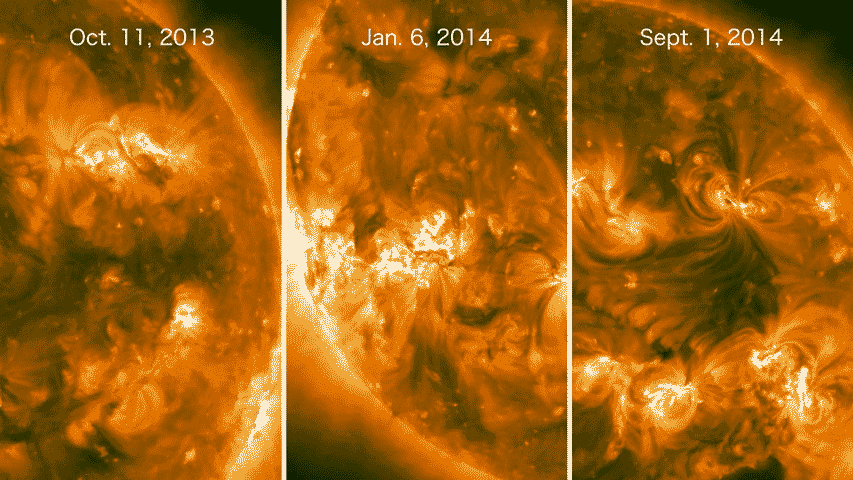Jan 31 2017
 These solar flares were imaged in extreme ultraviolet light by NASA's STEREO satellites, which at the time were viewing the side of the sun facing away from Earth. All three events launched fast coronal mass ejections (CMEs). Although NASA's Fermi Gamma-ray Space Telescope couldn't see the eruptions directly, it detected high-energy gamma rays from all of them. Scientists think particles accelerated by the CMEs rained onto the Earth-facing side of the sun and produced the gamma rays. The central image was returned by the STEREO A spacecraft, all others are from STEREO B. CREDIT: NASA/STEREO.
These solar flares were imaged in extreme ultraviolet light by NASA's STEREO satellites, which at the time were viewing the side of the sun facing away from Earth. All three events launched fast coronal mass ejections (CMEs). Although NASA's Fermi Gamma-ray Space Telescope couldn't see the eruptions directly, it detected high-energy gamma rays from all of them. Scientists think particles accelerated by the CMEs rained onto the Earth-facing side of the sun and produced the gamma rays. The central image was returned by the STEREO A spacecraft, all others are from STEREO B. CREDIT: NASA/STEREO.
According to an international science team, the Fermi Gamma-ray Space Telescope developed by NASA has detected high-energy light from solar eruptions occurring on the far side of the sun, which is expected to obstruct direct light from such events.
This evident paradox provides a unique tool to solar scientists, enabling them to explore the way in which charged particles are accelerated to almost equal to the speed of light and then get relocated across the sun when solar flares occurs.
Fermi is seeing gamma rays from the side of the sun we’re facing, but the emission is produced by streams of particles blasted out of solar flares on the far side of the sun. These particles must travel some 300,000 miles within about five minutes of the eruption to produce this light.
Nicola Omodei, Researcher, Stanford University
The outcomes of the research were presented by Omodei at the American Physical Society meeting in Washington on Monday, 30 January 2017. A paper giving a detailed account of the outcomes is to be published online on 31 January 2017 in The Astrophysical Journal.
From the time Fermi started to scan the sky in the year 2008, it has doubled the number of such rare events, known as behind-the-limb flares. The Large Area Telescope (LAT) equipped in Fermi has captured gamma rays that have energies close to three billion electron volts. Some of the rays were observed to have energies 30 times higher than the most energetic light earlier related to such “hidden” flares.
Credits go to the Solar Terrestrial Relations Observatory (STEREO) spacecraft developed by NASA that monitored the far side of the sun during the eruptions because Fermi events represent the maiden time that scientists have successfully performed direct imaging of beyond-the-limb solar flares related to high-energy gamma rays.
Observations by Fermi’s LAT continue to have a significant impact on the solar physics community in their own right, but the addition of STEREO observations provides extremely valuable information of how they mesh with the big picture of solar activity.
Melissa Pesce-Rollins, Researcher, National Institute of Nuclear Physics
The hidden flares were observed on 11 October 2013, and 6 January and 1 September 2014. All three events were related to fast coronal mass ejections (CMEs) in which billion-ton clouds of solar plasma were propelled into space. The speed of movement with which the CME from the most recent event left the sun was close to five million miles per hour. The scientists assume that the gamma-ray emission was the result of particles accelerated at the leading edge of the CMEs.
The acceleration site can be connected with the most distant part of the solar surface using large magnetic field structures. The research team suspects that particles accelerated at the CME move to the visible side of the sun along magnetic field lines that connect both the locations because charged particles should continue to be in contact with magnetic field lines.
Once the particles strike the surface, they initiate gamma-ray emission by means of different processes. One such well-known mechanism is proton collisions that generate pions, which quickly decay into gamma rays.
In the eight years since being commissioned, high-energy emission from over 40 solar flares has been observed by Fermi. Over half of the events are categorized as moderate, or M class, events. The highest energy emission to be ever detected from the solar surface was observed by Fermi in the year 2012 at the time of a powerful X-class flare. The LAT detected high-energy gamma rays for over 20 record-setting hours from this event.
Fermi Gamma-ray Space Telescope, a partnership of particle physics and astrophysics, was developed by NASA in collaboration with the U.S. Department of Energy and with significant contributions from partners and academic institutions in France, Germany, Italy, Japan, Sweden, and the United States.
Fermi Sees Gamma Rays from Far Side Solar Flares